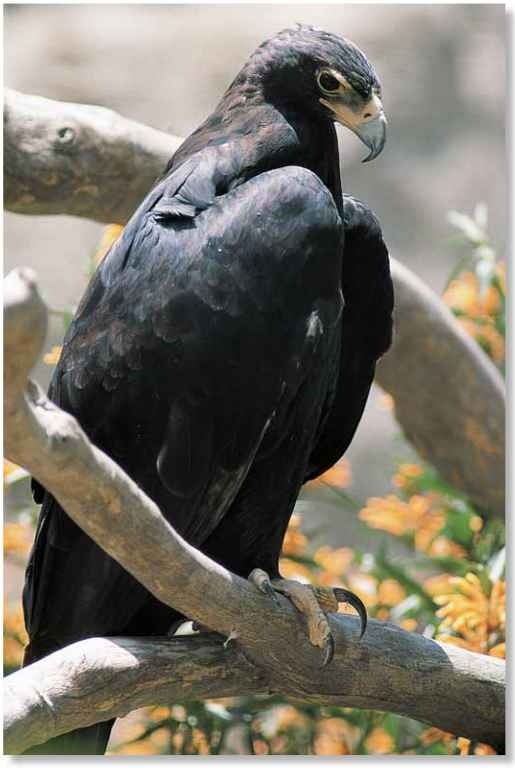ORDER
Falconiformes
FAMILY
Accipitridae
GENUS & SPECIES
KEY FEATURES
• Hunts entirely while in flight, swooping dowr rapidly to surprise its unsuspecting prey
• Builds a massive nest out of sticks and grass on the exposed side of a sheer cliff
• The elder chick almost always kills its younger sibling
• Also known as black eagles, these birds of prey feed mainly on the small hyrax
WHERE IN THE WORLD?
Found in both Chad and Sudan; also throughout Israel, Egypt and southeastern Arabian peninsula; also in Ethiopia to Somalia, with main ranges from Kenya to South Africa
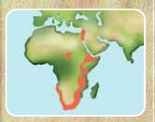
LIFECYCLE
A highly specialized hunter, Verreaux’s eagle relies on the element of surprise when it strikes; the eagle often swoops down a cliff to grab its favorite victim — the rock hyrax.
HABITAT
Verreaux’s eagle favors a rugged and extreme habitat; it ranges throughout the mountainous and desert terrain of most of sub-Saharan Africa.This eagle inhabits areas where its favorite meal, the hyrax, lives. Verreaux’s eagle searches out its prey in river gorges, rocky outcrops, hills and mountains all the way from sea level to over 15,000′, where the eagle builds large nests on exposed rocky cliffs.
High altitude The eagle prefers mountainous terrain, overlooking its domain.

The largest recorded Verreaux’s eagle nest is 13′ high.
Verreaux’s eagle has been known to attack creatures as large and powerful as leopards in defense of its nest.
Verreaux’s eagles have been the subject of an extremely long-term monitoring program which keeps track of their habits; it was established in 1964 in Matobo National Park, which is located in Zimbabwe.
BREEDING
Male Verreaux’s eagles mark the beginning of the breeding season with dramatic displays in which the bird plunges, climbs and swings.The female sometimes reciprocates with similar performances. These birds are monogamous and have been known to keep the same mate and nest for an entire lifetime.
Breeding occurs at different times throughout the year depending on the region. After mating the female lays two eggs 3-4 days apart in a nest made of sticks and grass, usually situated on the edge of a cliff.The first chick hatches in about 44 days and usually kills the younger chick. It makes its first flight 13-14 weeks later. Both parents feed the chick until it leaves the nest.

A Precarious perch Verreaux’s eagle nests on cliff edges.
ELEMENT OF SURPRISE
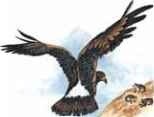
View from above…
Flying high above a mountain, a Verreaux’s eagle spots rock hyraxes that are sunning themselves on a rocky ledge.
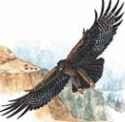
Coming in…
An accomplished aerialist, the eagle swoops down and around the rock outcrop, zooming in the hyrax colony.

Too late…
The eagle turns the corner and banks sharply among the rocks, surprising the hyrax just as it is getting up on its feet in alarm.
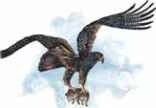
A fine catch
Verreaux’s eagle flies high into the air with its kill, making its way back to the nest where it will savor the meal.
BEHAVIOR
Usually silent, Verreaux’s eagle may utter whistling calls during mating season. If threatened, the eagle emits a savage bark. The territorial bird often perches in conspicuous places and lets other eagles know to stay away from its territory with warning calls; it will drive away an invader that violates its airspace. Pairs live together for years and respect their neighbors’ boundaries. As summer ends, eagle pairs begin repairing last year’s nest and prepare for the new season.
Hunting hyrax
The magnificent Verreaux’s eagle takes wing in search of the wily hyrax, which likes to hide in rocky outcrops.
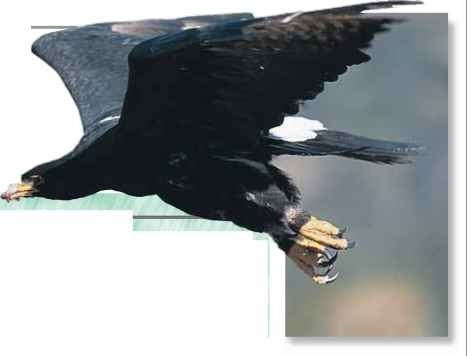
CONSERVATION
This widely distributed African eagle is not considered globally threatened. In fact, it is quite common in habitats that contain plenty of hyraxes, especially South Africa.Verreaux’s eagle populations are sparse on the Arabian Peninsula; these reduced numbers may be due to drought and hunting.
FOOD & HUNTING
The hyrax, a rock-dwelling mammal that resembles a cross between a rabbit and a guinea pig, accounts for at least 90% of the eagle’s diet. The eagle needs to consume about one hyrax a day to survive. Scoping out its prey from above, the eagle spots its unsuspecting victim and quickly strikes. If the hyrax tries to scurry into a rock crevice, the eagle is often able to surprise the small mammal by plucking it from its hiding place with its feet.
Often hunting in pairs, the eagle also eats birds and other small mammals.The eagle uses its sharp claws to grab its victim and fly back to its nest, where it eats its kill or stores the food until it is ready to be eaten.Verreaux’s eagle rips into the flesh of its prey and breaks it into pieces with its sharp beak before swallowing.
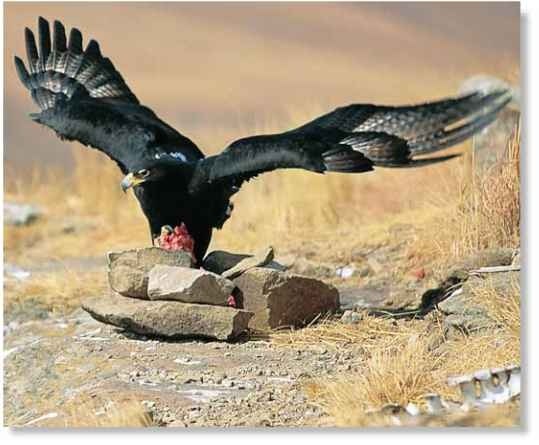
PROFILE
Verreaux’s Eagle
Verreaux’s eagle hunts for prey using its keen sense of vision; it spots its victim from high atop its perch before swooping in for the kill.
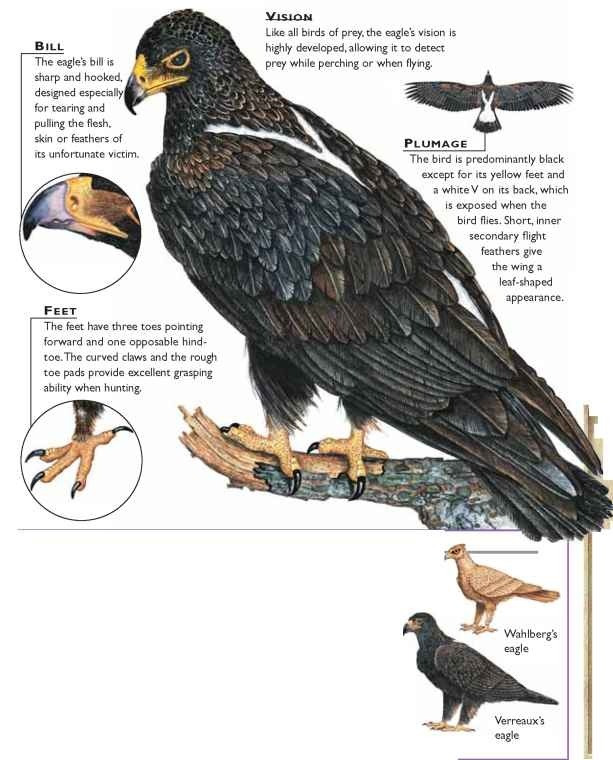
CREATURE COMPARISONS
Measuring about 2′ in length and weighing 2.5 lbs., Wahlberg’s eagle (Aquila wahlbergi) is smaller than Verreaux’s eagle. Like its relative, Wahlberg’s eagle usually lays two eggs, with the older hatchling killing the younger sibling. It spends most of its time on the wing searching out prey, but has a more varied diet than Verreaux’s eagle; the Walberg’s eagle eats squirrels, birds, snakes, frogs and small mongooses.The Wahlberg ranges in color from creamy white to dark brown, compared to the predominantly black Verreaux’s eagle. Like its relative, it makes its home in Africa, frequenting the savannah regions extending from the east and west coasts in northern Natal, Botswana, Namibia, Zimbabwe and Mozambique.
| VITAL | |
| STATISTICS | |
| Weight | Female 6.5-12 lbs.; male 6.5-9 lbs. |
| Length | 2.5-3′ |
| Sexual Maturity | Unknown |
| Breeding Season | All year, depending on region |
| Number of Eggs | 2 |
| Incubation Period | 44 days |
| Fledging Period | 3-6 months |
| Breeding Interval | 2-3 years |
| Typical Diet | Hyraxes, small mammals, reptiles and birds |
| Lifespan | About 16 years |
RELATED SPECIES
• There are 64 genera and 237 species in the family Accipitridae, one of the largest bird families. The 11 species in this genus are viewed as the most highly evolved in the family Accipitridae. Some of the more diverse members of the Aquila genus are the greater spotted eagle, Aquila clanga, the Tawny eagle, Aquila rapax and the steppe eagle, Aquila nipalensis.
